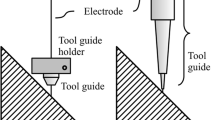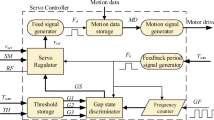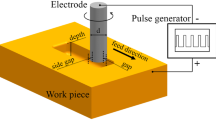Abstract
Fast hole electrical discharge machining (EDM) is widely used in drilling circular holes with sub-millimeter diameters on metal alloy materials. As a kind of non-contact machining process, the discharge gap between tool electrode and workpiece significantly affects the machining efficiency. Ordinarily, this process can achieve high machining efficiency based on large discharge energy and high pressure inner flush. However, in case of demanding high shape precision and surface quality, such as film cooling holes, the discharge energy needs to be reduced. Thus the electrode wear ratio is increased and the removal of machining debris becomes more difficult. Consequently, the control of discharge gap gets hard and then the machining efficiency is significantly decreased. In this research, a nonlinear velocity controller based on sliding mode control (SMC) method is proposed to improve servo control of discharge gap in precise fast hole EDM. The dynamic model of fast hole EDM is firstly established to provide the physical basis for the controller design. Then a sliding mode algorithm is designed based on Lyapunov stability theory to improve the anti-interference of the control system, and the dynamic characteristics are analyzed through simulations based on the state equation and control algorithm. Furthermore, the performance of the proposed method is discussed by comparing the tool electrode movement, gap average voltage and utilization ratio of pulses measured in experiments. The experimental results showed that the proposed method can increase machining efficiency by 38.1%.



















Similar content being viewed by others
References
Gao Q (2018) Impact of electrode length on EDM inclined hole drilling process. Int J Adv Manuf Technol 94(1-4):1171–1175
Boccadoro M, Dauw DF (1995) About the application of fuzzy controllers in high-performance die-sinking machines EDM. CIRP Ann-Manuf Technol 44(1):147–150
Behrens A, Ginzel J (2003) Neuro-fuzzy process control system for sinking EDM. J Manuf Process 5(1):33–39
Behrens AW, Ginzel J, Bruhns FL (2004) Threshold technology and its application for gap status detection. J Mater Process Technol 149(1-3):310–315
Tong H, Li Y (2012) Self-adaptive fuzzy controller with formulary rule for servo control of discharge gap in Micro EDM. High Technol Lett 18(3):223–229
Kaneko T, Onodera T (2004) Improvement in machining performance of die-sinking EDM by using self-adjusting fuzzy control. J Mater Process Technol 149(1-3):204–211
Fu XZ, Zhang QH, Gao LY, Liu QY, Wang K, Zhang YW (2016) A novel micro-EDM—piezoelectric self-adaptive micro-EDM. Int J Adv Manuf Technol 85(1-4):817–824
Xi XC, Chen M, Zhao WS (2017) Improving electrical discharging machining efficiency by using a Kalman filter for estimating gap voltages. Precis Eng 47:182–190
Rong H, Zhou K (2017) Nonlinear zero-bias current control for active magnetic bearing in power magnetically levitated spindle based on adaptive backstepping sliding mode approach. J Mech Eng Sci 231(20):3753–3765
Saghafinia A, Wooi PH, Nasir UM (2014) Fuzzy sliding mode control based on boundary layer theory for chattering-free and robust induction motor drive. Int J Adv Manuf Technol 71(1-4):57–68
Jafferson JM, Hariharan P, Kumar JR Effects of ultrasonic vibration and magnetic field in micro-EDM milling of nonmagnetic material. Mater Manuf Process 29(3):7
Qiao JH, Dai YP, Liu JK Sliding backstepping control for helicopters with nonlinear disturbance observer. Trans Beijing Inst Technol 29(3):224–228
Wang ZQ, Tong H, Li Y, Li CJ (2014) Multifunctional spindle for machining film cooling holes in EDM. J Tsinghua Univ 54(9):1131–1137
Acknowledgements
This research is supported by Tsinghua University Initiative Scientific Research Program (Grant No. 20131089209), and Science and Technology Support Program of Jiangsu Province of China (Grant No. BY2016024-01).
Author information
Authors and Affiliations
Corresponding author
Additional information
Publisher’s note
Springer Nature remains neutral with regard to jurisdictional claims in published maps and institutional affiliations.
Rights and permissions
About this article
Cite this article
Liang, W., Tong, H., Li, Y. et al. Sliding-mode controller and algorithm for improving servo control of discharge gap in precise fast hole EDM. Int J Adv Manuf Technol 105, 2689–2698 (2019). https://doi.org/10.1007/s00170-019-04481-9
Received:
Accepted:
Published:
Issue Date:
DOI: https://doi.org/10.1007/s00170-019-04481-9




